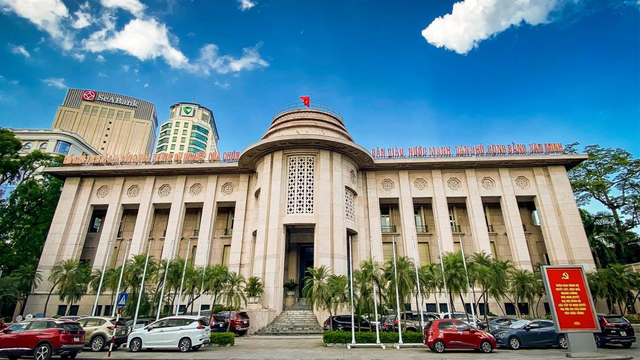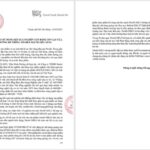
Illustrative photo
In the trading session of March 18, the State Bank of Vietnam (SBV) successfully conducted another auction of nearly VND 15,000 billion worth of 28-day bills for 12 market participants at an interest rate of 1.4% per annum. This is the sixth consecutive auction in which the SBV has offered bills to absorb excess liquidity in the banking system, with a total accumulated volume of nearly VND 90,000 billion. This amount will be injected into the system by the SBV starting from April 8.
As we previously reported, the SBV resumed the issuance of bills in the session held on March 11 after a suspension of over 4 months. The resumption of bill auctions demonstrates the SBV’s aim of absorbing excess liquidity in the banking system, thereby boosting the VND interest rate in the interbank market, indirectly curbing the upward momentum of the USD/VND exchange rate, which is currently under pressure and being traded at historically high levels.
The winning volume in the last 6 sessions all reached nearly VND 15,000 billion per session, with a winning interest rate of 1.4% (relatively high compared to the previous period of nearly VND 10,300 billion and 1.05%), showing that the SBV is quite aggressive in liquidity absorption activities.
Meanwhile, the interest rate in the interbank market has reversed its downward trend in the last 2 trading sessions. According to the latest data published by the SBV, the average VND interbank interest rate in the overnight term (the main term accounting for about 90% of the transaction value) decreased to 0.79% in the session of March 15 from the 1.21% level recorded in the session of March 14 and the 1.47% level in the session of March 13.
Other key term interest rates also tended to decrease as follows: the 1-week term decreased from 1.68% to 1.1%; the 2-week term decreased from 1.81% to 1.43%; the 1-month term decreased from 2.01% to 1.6%.
The reduction in the interbank interest rate, together with the relatively high number of members participating in the bill auctions, reflects the fact that the system liquidity is still quite abundant. This will drive the likelihood that the SBV will continue to issue more bills in the future.
Looking back at the most recent bill issuance period from September 21 to November 8, 2023, the SBV issued bills in 35 consecutive sessions with a total accumulated volume of VND 360,345 billion. Among them, the highest net absorption (cumulative volume of bills issued – cumulative volume of bills matured) during this period was VND 255,600 billion.
After the SBV withdrew funds, the exchange rate began to decrease and maintained a downward trend until the end of November 2023. The interbank overnight interest rate increased sharply to over 2% during the period from September 21 to October 25, 2023 – in response to the fund withdrawal. The SBV ceased the issuance of bills from the session of November 9, 2023, when the exchange rate began to cool down and gradually injected the previously withdrawn funds back into the system.
Regarding the bill issuance session starting from March 11, 2024, analysts believe that the SBV’s decision to use the bill instrument again is intended to support the exchange rate as the exchange rate has recently increased sharply due to: (1) the USD-VND interest rate differential still being relatively high; (2) the DXY-Index increasing (although still at a low level of 102.8); (3) the Fed signaling a delay in the interest rate cut from the first quarter to the second quarter of 2024.
The SBV’s bill issuance move is considered reasonable and a proactive step ahead of the upcoming Fed meeting. In case the Fed takes a firm stance on monetary policy and the US Dollar appreciates accordingly, the SBV has preemptive actions, with room to maneuver and is in a more proactive position to cope. If the Fed’s orientation becomes more flexible and the global market stabilizes, the SBV can suspend net absorption and gradually inject the withdrawn funds back into the system.
In a new analysis report, BSC points out that the net absorption of bills is a business operation, a regulatory tool, and does not imply reversals in policy. The short-term objective when the SBV issues bills is to regulate liquidity in the market in the short term to impact the exchange rate. In the long term, bill issuance is aimed at stabilizing the exchange rate, interest rates, liquidity, etc. to serve the long-term goals of monetary policy.
Prior to this, in the period from 2018 to 2023, the SBV carried out this operation regularly multiple times a year. Statistics from BSC show that the SBV carried out net absorption on average about 9.7 times per year during this period, with the average number of days from the beginning of the cycle to the end of the cycle being about 13.4 days. The average net absorption value/cycle reached VND 43,385 billion. The largest net absorption value/cycle was VND 191,100 billion in 2022.
Based on the above assessments, BSC predicts that the largest scale of net absorption (cumulative volume of bills issued – cumulative volume of bills matured) in this period may be around VND 150,000 billion.
Sharing with the author, an expert with many years of experience in capital sourcing business activities at banks commented that the scale of this bill issuance phase could be equivalent to or less than that of the period in September 2023, as credit will soon start to increase again, causing the system liquidity to no longer be excessively abundant.





































